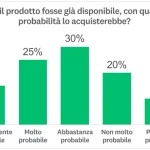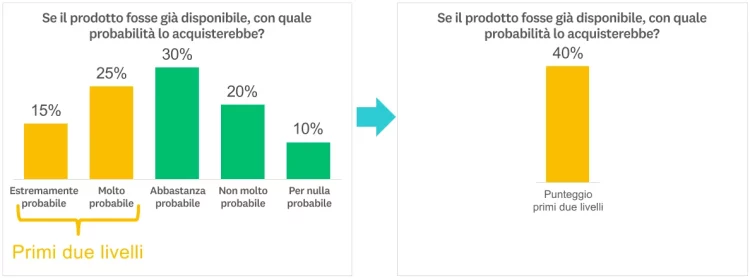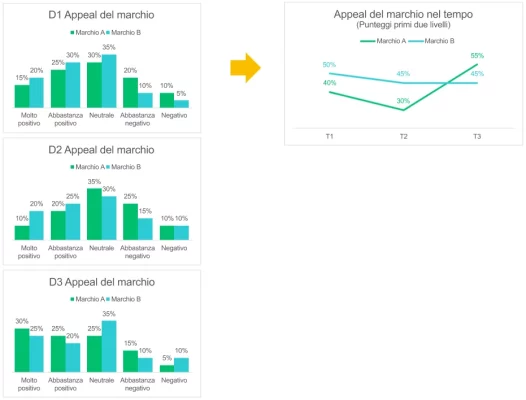Come utilizzare il punteggio dei primi due livelli nell'analisi dei risultati dei sondaggi

Quanto sono propensi i tuoi potenziali acquirenti a scegliere i tuoi prodotti? I tuoi clienti sono soddisfatti? E il tuo marchio attira interesse?
È probabile che ognuna di queste domande produca una serie di risposte differenti, il che ne complica l'interpretazione. Per rendere più semplice l'analisi delle risposte, puoi ricorrere alla tecnica del punteggio dei primi due livelli, che ti permette di evidenziare i valori chiave in modo facilmente intuibile.
In questo articolo, vedremo come il punteggio dei primi due livelli può venirti in aiuto nella fase di analisi dei dati delle indagini. Inoltre, esamineremo le sue varianti più utilizzate. Così, la prossima volta che dovrai preparare le domande o rivedere le risposte di un questionario, potrai sfruttare al meglio questo strumento per ottenere il massimo dai risultati del tuo sondaggio.
Innanzitutto, che cosa si intende esattamente per punteggio dei primi due livelli?
Definizione di punteggio dei primi due livelli
Il punteggio dei primi due livelli (o Top 2 Box, T2B) è un criterio per sintetizzare le risposte positive di un quesito a scala Likert . Combina le due risposte migliori della scala per creare un valore unico. Data la semplicità di calcolo e la sua utilità ai fini dell'analisi, questo sistema di punteggio viene utilizzato in diversi modi nell'ambito delle ricerche di mercato, ad esempio per la verifica delle campagne pubblicitarie, lo sviluppo dei prodotti o il monitoraggio del marchio.
Per comprendere meglio come si calcola il punteggio Top 2 Box, vediamo subito un esempio.
Calcolo del punteggio dei primi due livelli
Supponiamo che tu sia responsabile per il marketing presso un'azienda che produce alimenti per animali domestici e voglia testare un paio di idee pubblicitarie sul tuo mercato di riferimento, ovvero i proprietari di animali da compagnia. Nel tuo sondaggio, cercherai di capire quanto è probabile (o improbabile) che acquistino il tuo prodotto dopo aver visto una pubblicità.
Prendiamo, ad esempio, la seguente domanda sull'intenzione di acquisto con 5 opzioni di risposta:
Se il prodotto fosse già disponibile, con quale probabilità lo acquisterebbe?
- Estremamente probabile
- Molto probabile
- Abbastanza probabile
- Non molto probabile
- Per nulla probabile
Una volta raccolte le risposte, i dati potrebbero apparire così:

Quale professionista del marketing, probabilmente ti interesserà individuare la percentuale di persone propense ad acquistare il prodotto dopo aver visto la pubblicità. In questo esempio, sono le risposte delle due colonne più a sinistra a fornire i riscontri positivi, ovvero Estremamente probabile e Molto probabile. Per calcolare il punteggio dei primi due livelli, devi semplicemente sommare i valori di queste due risposte:
15% (Estremamente probabile) + 25% (Molto probabile) = 40% (Primi due livelli)

Suggerimento: lo strumento di analisi di SurveyMonkey permette di calcolare facilmente il punteggio dei primi due livelli combinando le opzioni di risposta.
Ora che abbiamo visto come calcolare il punteggio dei primi due livelli, scopriamo perché utilizzarlo.
Perché usare il punteggio dei primi due livelli?
1) L'analisi risulta semplificata. Anziché esaminare 5 o più numeri, dovrai valutarne solo uno.
2) I confronti sono facili e veloci. Sia che si tratti di confrontare i risultati di diversi marchi o stimoli (come nella verifica dei concetti), i punteggi dei primi due livelli consentono di paragonare i risultati fianco a fianco in modo più efficace.
Riprendiamo l'esempio precedente dell'azienda di alimenti per animali. Immagina di aver posto non solo domande sull'intenzione di acquisto, ma anche sull'appeal e sulla credibilità del marchio. Con i punteggi dei primi due livelli, potrai dire addio a tutta una serie di grafici difficili da interpretare e passare a semplici schede di valutazione dei risultati.

3) Sarà più facile identificare le tendenze. Se intendi monitorare alcune metriche nel tempo, i punteggi dei primi due livelli ti aiuteranno a identificare le tendenze dei dati.
Ad esempio, supponiamo che tu voglia tenere sotto controllo l'appeal del tuo marchio rispetto a quello del tuo principale concorrente. Puoi usare una domanda con 5 opzioni di risposta che misura la percezione relativa di ciascun brand. Monitorando i risultati su base trimestrale, potrai osservare l'andamento dei due marchi, uno accanto all'altro.
I punteggi dei primi due livelli consentono di catturare l'analisi relativa a un intervallo di tempo in un'unica visualizzazione.

Vuoi mettere alla prova il tuo istinto?
SurveyMonkey Audience ti mette a disposizione consumatori di tutto il mondo che possono dirti cosa pensano.
Varianti del punteggio dei primi due livelli
Esistono diverse varianti del punteggio dei primi due livelli. Ecco le più comuni:
Punteggio del primo livello
Puoi utilizzare il punteggio del primo livello quando ti interessa valutare solo le posizioni più alte in classifica. Ad esempio, se il tuo obiettivo è migliorare la fidelizzazione dei clienti e intendi utilizzare una domanda con valutazione a stelle per misurarne la soddisfazione, potresti concentrarti sull'aumento nel tempo della percentuale di clienti che ti assegnano 5 stelle.
Come valuta i nostri servizi?
- ★★★★★
- ★★★★
- ★★★
- ★★
- ★
Per calcolare il punteggio del primo livello, è sufficiente trovare la percentuale di persone che ha selezionato l'opzione migliore. Quindi, se il 20% degli intervistati ha selezionato 5 stelle, il punteggio del primo livello corrisponderà a 20%.
Punteggio dei primi tre livelli
Puoi utilizzare il punteggio dei primi tre livelli per domande a scala Likert con più di 5 opzioni di risposta. Il calcolo è simile a quello per il punteggio dei primi due livelli, solo che dovrai sommare le prime tre risposte positive.
Ritiene il servizio di assistenza ricevuto soddisfacente o insoddisfacente?
- Estremamente soddisfacente
- Molto soddisfacente
- Soddisfacente
- Né soddisfacente né insoddisfacente
- Insoddisfacente
- Molto insoddisfacente
- Estremamente insoddisfacente
Punteggio degli ultimi due livelli
Se ti interessa raggruppare le risposte negative di una domanda a scala Likert, potresti usare gli ultimi due livelli anziché i primi due. Prendiamo, ad esempio, questa domanda sulla fedeltà al marchio tratta dal nostro modello di indagine sulla conversione del marchio:
Quanto è probabile che si rivolga a un altro brand per il prossimo acquisto?
- Estremamente probabile
- Molto probabile
- Abbastanza probabile
- Non molto probabile
- Per nulla probabile
Per creare una metrica che quantifichi i tuoi clienti fedeli, puoi calcolare il punteggio degli ultimi due livelli. Ti basterà sommare i valori delle ultime due opzioni di risposta ("Non molto probabile" e "Per nulla probabile").
Punteggio ponderato dei primi due livelli
Di tanto in tanto, può essere utile approfondire i risultati dei primi due livelli. Esaminiamo, ad esempio, la ripartizione dei seguenti punteggi dei primi due livelli relativi a una domanda sull'intenzione di acquisto di due diversi concept di prodotto:
Prodotto A
Punteggio primi due livelli: 40%
Estremamente probabile: 15%
Molto probabile: 25%
Prodotto B
Punteggio primi due livelli: 40%
Estremamente probabile: 30%
Molto probabile: 10%
In questo caso, i punteggi dei primi due livelli ottenuti dai due prodotti sono identici, ma ciò non deve trarre in inganno. Infatti, il prodotto B ha registrato il doppio delle risposte migliori (Estremamente probabile), il che significa che il pubblico è decisamente più intenzionato ad acquistare questo prodotto rispetto al prodotto A.

Questo esempio dimostra che non si può sempre fare affidamento esclusivamente sul punteggio aggregato dei primi due livelli, soprattutto se i risultati dei confronti sono molto vicini. L'utilizzo del punteggio ponderato dei primi due livelli (o del solo punteggio del primo livello) può fornire maggiore chiarezza ed evitarti di dover testare nuovamente la campagna pubblicitaria o di ripetere l'indagine per aumentare la dimensione del campione.
Calcolo del punteggio ponderato dei primi due livelli
Il punteggio ponderato dei primi due livelli si calcola nel modo seguente:
(Punteggio primo livello * Peso di ponderazione primo livello) + (Punteggio secondo livello * Peso di ponderazione secondo livello) = Punteggio ponderato primi due livelli
Le variabili discrezionali dell'equazione sono proprio i pesi di ponderazione. Ecco alcune regole empiriche per determinare tali valori per i punteggi dei primi due livelli:
- I pesi di ponderazione del primo e del secondo livello non possono essere uguali.
- La somma dei due pesi di ponderazione deve corrispondere a 1.
- Il peso di ponderazione del primo livello è in genere superiore a quello del secondo livello. Questo perché il primo livello di una scala Likert ordinale corrisponde solitamente all'opzione di risposta più positiva, che meglio può predire la performance del mercato.
- Quando si stabiliscono i pesi di ponderazione, si deve tenere conto della categoria di prodotto e della capacità decisionale del consumatore. Se i prodotti sono economici e facili da acquistare (ad esempio, il dentifricio), i consumatori saranno in grado di fornire risposte più accurate, per cui è possibile attribuire al primo livello un peso maggiore. Se invece i prodotti richiedono una maggiore riflessione (ad esempio, un'automobile), al primo livello si dovrà attribuire un peso solo leggermente superiore.
I punteggi dei primi due livelli sono fondamentali per qualsiasi ricerca di mercato. Sia che si raccolgano dati relativi a campagne pubblicitarie, feedback sui prodotti o notorietà del marchio, miglioreranno l'efficienza in fase di analisi dei risultati e aiuteranno a prendere le decisioni migliori.
Scopri altre risorse

Elenco dei toolkit
Scopri i nostri toolkit, progettati per aiutarti a sfruttare i feedback per il tuo ruolo o settore.

Modelli di indagine
Oltre 400 modelli di questionari personalizzabili redatti da esperti per creare e inviare indagini coinvolgenti in modo rapido.

Moduli per colloqui di fine rapporto per capire cosa migliorare
Poni le domande giuste nei colloqui di fine rapporto per ridurre l'abbandono dei dipendenti. Inizia oggi stesso con i nostri strumenti e modelli.

Ricevi le autorizzazioni necessarie con i moduli di consenso online
Ottieni le autorizzazioni necessarie con un modulo di consenso personalizzato. Registrati gratis per creare i tuoi moduli a partire dai nostri modelli.